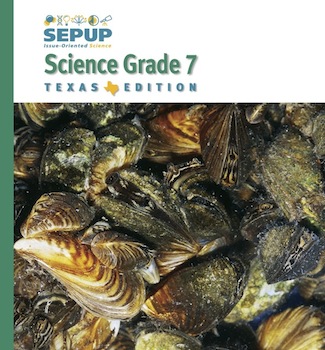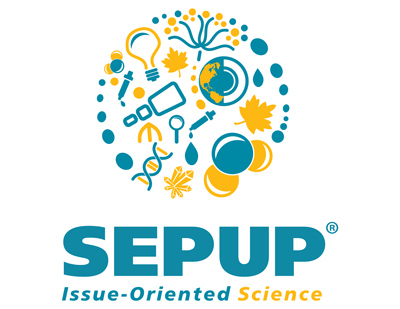SEPUP Science Grade 7 – Texas Edition

SEPUP Science Grade 7 is an issue-oriented year-long science course created to meet the Texas Essential Knowledge and Skills (TEKS) for the 7th grade. It is organized into seven units.
SEPUP Science students conduct experiments, collect and analyze data, create models, and read and analyze information. There is a +450-page, hard-cover student book, a complete Teacher’s Guide, and a kit containing the laboratory equipment and supplies required to conduct course activities. The kit provides supplies for use with up to five classes of 32 students each.
Summary
- How might an introduced species affect ecosystem sustainability?
- What can you do to reduce your personal health risk?
- How do catastrophic events impact ecosystems?
SEPUP Science Grade 7 is an issue-oriented year-long science course created to meet the Texas Essential Knowledge and Skills (TEKS) for the 7th grade. It is organized into seven units.
SEPUP Science students conduct experiments, collect and analyze data, create models, and read and analyze information. There is a +450-page, hard-cover student book, a complete Teacher’s Guide, and a kit containing the laboratory equipment and supplies required to conduct course activities. The kit provides supplies for use with up to five classes of 32 students each.
Description of Units:
1. Body Systems
Students explore the role of organ systems in maintaining homeostasis by providing nutrients and oxygen to the body, transporting and eliminating wastes, and responding to stimuli. They investigate the role of cells, tissues, organs, and organ systems in the human organism as they evaluate and make recommendations for healthy living.
Core Science Content: Body systems structure and function, circulatory, respiratory, skeletal, muscular, digestive, excretory, reproductive, integumentary, nervous, endocrine, adaptations, modeling
2. Cell Structure and Function
Students observe and study similarities and differences in the structure and function of plant and animal cells, tissues, and organs. They also investigate microbial cells, and apply what they learn about cell theory and the germ theory of disease to a simulated infectious disease outbreak.
Core Science Content: Microscopy, cell theory, plant and animal cell structure and function, cell organelles, levels of organization and their contribution to the functions of the organism, microbe structure and function
3. Genetics
The fundamental principles of Mendelian genetics are examined in several models. Students study asexual and sexual reproduction, the process of cell division, and the inheritance of traits as they examine how these processes affect diversity in offspring.
Core Science Content: Asexual and sexual reproduction, heredity, probability, genes, chromosomes
4. Ecology
Students consider what happens when a new species is introduced into an ecosystem. They model ecological relationships within an ecosystem; explore energy flow; and investigate local ecosystems. The class establishes a compost bin that includes redworms.
Core Science Content: Introduced species, biodiversity, energy flow in food webs, energy pyramids, photosynthesis, cycling of matter, biomes, ecological succession, dichotomous key
5. Evolution
Should an extinct species be brought back to life? That question is posed as students examine natural selection, lines of evidence for evolution, and the role of genetic mutations. They study the effect of humans on the evolution of species, including endangered and extinct species.
Core Science Content: adaptation, competition, endangered species, extinction, variation, natural selection, selective breeding
6. Environmental Change
In the context of understanding the effects of natural disasters such as hurricanes, tornados, and floods on Texas’s ecosystems, students first investigate soil types and their distribution in the US and Texas. Students then use stream tables and various earth materials to explore the effects of weathering, erosion, and deposition. Throughout the unit they also consider how various human activities, such as using fertilizers and building seawalls, can increase or decrease the harmful effects of natural forces.
Core Science Content: Texas ecoregions, ecosystems, natural disasters, soils, erosion, deposition, weathering, landforms, human impact, observation, data collection, experimental design
7. Life in Space
Students learn about the search for habitable planets and in doing so are introduced to the concept of the habitable zone around a star. They read about the forces involved in leaving the earth and exploring space and investigate the accommodations necessary for manned space flight. Students also investigate how plants respond to light, gravity, and water as they learn about growing plants in space. Finally, they discuss where to set up a space settlement that would facilitate deeper, manned exploration of space.
Core Science Content: Forces and work, turgor pressure, geotropism and phototropism, accommodations for manned space exploration, characteristics of planetary objects that support life, habitable zone

